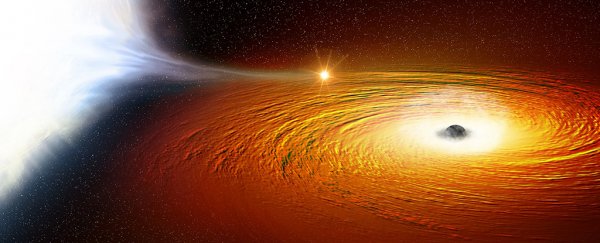Astronomers have just spotted a star whizzing around a vast black hole at about 2.5 times the distance between Earth and the Moon, and it takes only half an hour to complete one orbit.
To put that into perspective, it takes roughly 28 days for our Moon to do a single lap around our relatively tiny planet at speeds of 3,683 kilometres (2,288 miles) per hour, meaning this star is moving at some mind-boggling, break-neck speeds.
Using data from an array of deep space telescopes, a team of astronomers have measured the X-rays pouring from a binary star system called 47 Tuc X9, which sits in a cluster of stars about 14,800 light-years away.
The pair of stars aren't new to astronomers - they were identified as a binary system way back in 1989 - but it's now finally becoming clear what's actually going on here.
"For a long time, it was thought that X9 is made up of a white dwarf pulling matter from a low mass Sun-like star," said researcher Arash Bahramian.
When a white dwarf pulls material from another star, the system is described as a cataclysmic variable star. But back in 2015, one of the objects was found to be a black hole, throwing that hypothesis into serious doubt.
Data from Chandra has confirmed large amounts of oxygen in the pair's neighbourhood, which is commonly associated with white dwarf stars. But instead of a white dwarf ripping apart another star, it now seems to be a black hole stripping the gases from a white dwarf.
White dwarfs are super dense objects that are usually the remnants of a star - think of something with the mass of our Sun but only as big as our planet - so pulling material from its surface would require some impressive gravity.
"We think the star may have been losing gas to the black hole for tens of millions of years and by now has now lost the majority of its mass," said researcher James Miller-Jones from Curtin University and the International Centre for Radio Astronomy Research.
The real exciting news, however, is regular changes in the X-rays' intensity suggest this white dwarf takes just 28 minutes to complete an orbit, making it the current champion of cataclysmic dirty dancers.
"Prior to this discovery, the closest star around any likely black hole was a system known as MAXI J1659-152, which is in an orbit with a 2.4-hour period," said Miller-Jones.
"If the likely black holes in both systems have similar masses, this would imply an orbit three times larger in physical size than the one we found in X9."
To put it in perspective, the distance between the two objects in X9 is about 1 million kilometres (about 600,000 miles), or about 2.5 times the distance from here to the Moon.
Crunching the numbers, that's a journey of roughly 6.3 million kilometres (about 4 million miles) in half an hour, giving us a speed of 12,600,000 km/hr (8,000,000 miles/hr) - about 1 percent of the speed of light.
"Finding these rare black holes is important, as they are not only the end points of massive stars, produced in supernova explosions, they also continue to play a role in the evolution of other stars after their deaths," Geraint Lewis from the University of Sydney told Marcus Strom at The Sydney Morning Herald.
Our two star-crossed lovers aren't fated to collapse into each other's arms any time soon, at least, with the dance looking like it will continue without the white dwarf falling into the black hole or being ripped apart.
In fact, if anything, it seems the two objects were even closer together in the past and orbiting even faster.
For the black hole to overcome the white dwarf's own intense gravity, the bodies need to be fairly close together. Over time, as material is stripped away, the now-lighter white dwarf would slip a little further back.
"Eventually so much matter may be pulled away from the white dwarf that it ends up only having the mass of a planet," said researcher Craig Heinke. "If it keeps losing mass, the white dwarf may completely evaporate."
That's good news for future scientists keen to study gravitational waves; while the current technology used by the Laser Interferometer Gravitational-Wave Observatory isn't able to spot the slow pulses emitted by X9, it's not out of the question that progress in that field will one day allow us to detect lower frequency waves.
Of course, by then we might have found a new king and queen of cataclysmic variable stars, spinning the night away at even faster speeds.
This research has been published in the Monthly Notices of the Royal Astronomical Society and you can read it in full at arXiv.org.
